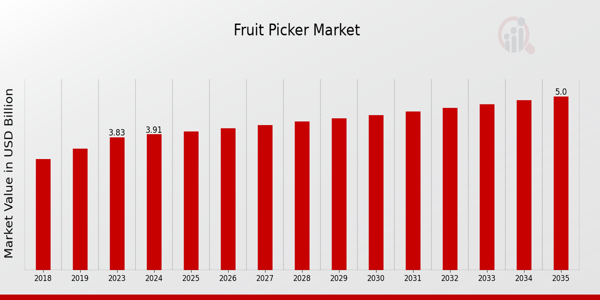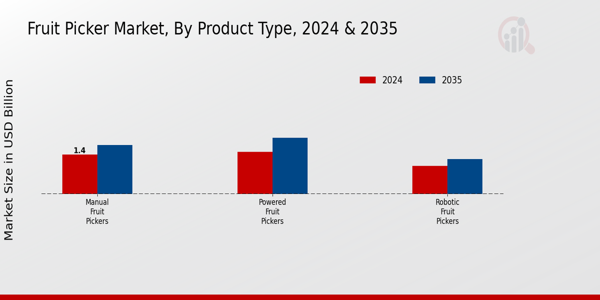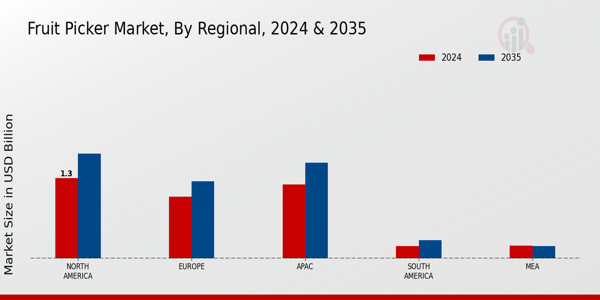Global Fruit Picker Market Overview
Fruit Picker Market Size was estimated at 3.83 (USD Billion) in 2023.The Fruit Picker Market is expected to grow from 3.91 (USD Billion) in 2024 to 5.0 (USD Billion) by 2035. The Fruit Picker Market CAGR (growth rate) is expected to be around 2.25% during the forecast period (2025 - 2035).

Key Fruit Picker Market Trends Highlighted
The growing demand for fresh produce and the lack of workers in the agriculture industry are driving the Fruit Picker Market's notable expansion. As labor prices increase and the demand for effective harvesting techniques increases, farming automation has become crucial.
The adoption of cutting-edge fruit-picking technology, which promise to increase productivity and lower operating costs, is being pushed by this trend.
Concerns about the environment also come into play, as more farms adopt sustainable methods that satisfy consumer demands for locally grown and organic produce. The market is full of opportunities, particularly for businesses that prioritize creating novel solutions.
Fruit picking efficiency can be increased by putting greater emphasis on automation, robotics, and data analytics.
Growing competition and a lack of labor are two issues that new technologies can help growers overcome. Furthermore, there is a chance that digital firms and agricultural enterprises will work together to develop customized solutions that address certain crop requirements.
Investment in research and development can lead to breakthroughs that transform the industry, making it essential for stakeholders to remain agile and responsive to changes. Trends in recent times point towards the integration of smart technologies in fruit-picking processes. Drones and AI-enabled machinery are gaining traction, allowing for better monitoring and handling of crops.
Furthermore, the rise of precision agriculture techniques is changing how fruit is harvested and processed, optimizing yield and quality.
As sustainability remains a priority, there is a growing focus on minimizing waste and maximizing the use of recyclable materials in fruit-picking equipment. As the market evolves, staying informed about these trends will be crucial for all participants.
Fruit Picker Market Drivers
Increasing Demand for Organic Fruits
The Fruit Picker Market is witnessing a significant surge in the demand for organic fruits as consumers become more health-conscious and environmentally aware. This growing preference for organic produce necessitates efficient harvesting techniques, thereby increasing the demand for modern fruit-picking equipment.
The shift towards organic farming practices has compelled farmers to adopt specialized fruit pickers that minimize damage to crops, maintain quality, and reduce the reliance on manual labor.
As a result, the market for sophisticated fruit-picking tools is expanding. The trend of healthy eating and the inclination towards organic products among consumers is expected to persist, creating a robust market for fruit pickers.
Additionally, increased focus on sustainable agriculture practices and the need to enhance productivity without compromising quality further propel the adoption of innovative harvesting technologies. Hence, the emphasis on organic fruits plays a crucial role in driving growth in the Fruit Picker Market, as producers look for durable, efficient, and effective tools to satisfy the escalating market demands.
Technological Advancements in Harvesting Equipment
Technological innovations play a pivotal role in enhancing the efficiency and effectiveness of fruit-picking processes in the Fruit Picker Market.
Advances in automation, robotics, and precision agriculture are making it possible to develop sophisticated fruit-picking machines that can harvest crops faster and with greater precision. This is particularly important in an era where labor shortages are becoming a significant challenge for farmers.
The implementation of smart technology and data analytics ensures that fruit pickers are not only efficient but also help in minimizing wastage and maximizing yield. Implementing such technology directly impacts the productivity of fruit growers and represents a critical driver for the growth of the market.
Labor Shortages in Agriculture
Labor shortages in the agricultural sector are driving farmers and producers to seek more efficient harvesting solutions within the Fruit Picker Market.
As populations decline in rural areas and younger generations pursue careers outside of agriculture, the availability of manual labor for picking fruits becomes increasingly limited. Consequently, farmers are compelled to invest in mechanized equipment that can compensate for the lack of workers.
This shift from manual to automated or semi-automated harvesting methods not only addresses labor shortages but also enhances operational efficiency. By reducing reliance on human labor, producers can effectively manage labor costs and ensure timely harvesting, thereby driving growth for fruit-picking equipment manufacturers.
Fruit Picker Market Segment Insights
Fruit Picker Market Product Type Insights
The Fruit Picker Market was segmented primarily by Product Type, encompassing Manual Fruit Pickers, Powered Fruit Pickers, and Robotic Fruit Pickers.
In 2024, the market for Manual Fruit Pickers was valued at 1.4 USD Billion, which positioned it as a significant player in the overall market landscape. Manual fruit pickers were essential due to their low operational cost and ease of use, particularly for smaller farms where automation isn't feasible.
This sub-segment continues to enjoy steady demand from traditional growers who value the control and skill involved in handpicking fruits, contributing to their prominent market standing.
On the other hand, Powered Fruit Pickers accounted for a market valuation of 1.5 USD Billion in 2024, highlighting their growing acceptance among commercial orchards seeking efficiency without fully transitioning to automation. This product type provided enhanced productivity and reduced labor costs, which appeals to larger-scale operations aiming to maximize yield during harvesting seasons.
Moreover, Robotic Fruit Pickers, with a valuation of 1.01 USD Billion in 2024, signified a rising trend towards automation in agricultural practices. Although this segment held the smallest share, it showcased considerable growth potential due to technological advancements that facilitate precise and efficient harvesting, attracting interest from tech-savvy growers and investors alike.
As the Fruit Picker Market evolves, the varying needs of these segments highlighted the dynamic nature of agricultural mechanization, with each product type playing an integral role in shaping market statistics and driving market growth through innovation and operational effectiveness.

Fruit Picker Market Fruit Type Insights
Among the various fruit types, specific categories play a critical role in shaping the market landscape. Apples, for instance, have historically been a major contributor due to their high yield and large-scale cultivation worldwide. Similarly, oranges and berries also dominate the market, appealing to consumers' growing health consciousness and preference for fresh produce.
Grapes, particularly for winemaking, are another significant segment that often necessitates specialized picking equipment to maintain quality. Peaches, enjoying a rise in popularity due to their versatility, further bolsters the market dynamics.
The segmentation of the Fruit Picker Market provides valuable data, revealing how different fruit types influence market statistics and trends, contributing to overall market growth and opportunities in the industry.
Factors such as technological advancements in harvesting, increasing labor costs, and the need for enhanced productivity drive the market forward, positioning it for a promising growth trajectory in the coming years.
Fruit Picker Market End Use Insights
The Fruit Picker Market has seen diverse opportunities across various End Use categories, with significant relevance for Commercial Farming, Home Gardening, and Agriculture Rental Services.
Commercial Farming continues to dominate the market due to the growing emphasis on enhancing productivity and efficiency through mechanization. Home Gardening is gaining traction as more individuals turn to sustainable practices and fresh produce cultivation, leading to a notable rise in personal fruit-picking tools and equipment.
Agriculture Rental Services have emerged as a critical segment, providing flexible access to fruit-picking machinery for smaller farmers who may not be able to afford to invest heavily.
The diverse scenarios of usage across these End Use categories highlight the ways in which the Fruit Picker Market revenue is bolstered by both professional and recreational growers, while market growth is further driven by advancements in technology and increasing focus on sustainable agriculture practices. However, challenges such as market competition and the need for continuous innovation remain prevalent.
Overall, the Fruit Picker Market segmentation showcases a promising trajectory supported by shifting consumer preferences and the rise of farming as a vital industry.
Fruit Picker Market Material Insights
The Fruit Picker Market has been experiencing steady growth, particularly within the Material segment, which includes various materials like Plastic, Metal, and Composite Materials. Plastic materials are increasingly favored due to their lightweight nature and resistance to corrosion, which offers ease of use in different agricultural settings.
Metal, traditionally used for its strength and durability, serves as a reliable choice for farmers seeking robust fruit pickers capable of handling heavy loads in challenging environments.
Meanwhile, Composite Materials are gaining traction due to their unique combination of lightness and strength, catering to a market that emphasizes both efficiency and ease of transport. The segmentation of materials in the Fruit Picker Market reflects changing consumer preferences geared toward sustainable and efficient agricultural solutions.
As this market evolves, these materials will play a pivotal role in driving innovation and meeting the diverse needs of fruit growers globally, presenting significant opportunities for market growth.
Fruit Picker Market Regional Insights
North America held a majority holding within the market, valued at 1.3 USD Billion, driven by advanced agricultural practices and technology adoption, expected to grow to 1.7 USD Billion by 2035. Europe followed with a significant presence at 1.0 USD Billion in 2024, benefiting from a strong focus on sustainable farming, projected to reach 1.25 USD Billion by 2035.
The APAC region, valued at 1.2 USD Billion in 2024, demonstrated notable growth potential with increasing fruit production and consumption, forecasted to expand to 1.55 USD Billion by 2035.
In contrast, South America and MEA showed smaller market sizes, valued at 0.2 USD Billion and 0.21 USD Billion, respectively, in 2024, growing to 0.3 USD Billion and 0.2 USD Billion by 2035. The relatively lower valuation in South America and the MEA highlighted the ongoing challenges, including infrastructure and investment in agricultural technologies.
Overall, the Fruit Picker Market segmentation showcased varied growth trajectories and opportunities across these regions, driven by local demand and market dynamics.

Fruit Picker Market Key Players and Competitive Insights:
The Fruit Picker Market is characterized by a complex landscape comprised of diverse players that create an environment marked by innovation, competition, and strategic collaborations. This market primarily focuses on agricultural machinery that aids in the efficient harvesting of fruits, contributing to enhanced productivity and economic growth within the agricultural sector.
With the rising demand for fruits due to health trends and an increasing population, the market is witnessing significant technological advancements aimed at improving the efficiency and effectiveness of fruit-picking processes.
Competitors in the market are actively pursuing strategies that include product differentiation, cost-leading practices, and geographical expansion to capture a larger share of the growing demand for fruit-picking solutions.
Grimme has established a robust presence within the Fruit Picker Market, recognized for its strong emphasis on quality and innovation. The company has developed advanced harvesting equipment that integrates modern agricultural technology, enhancing the efficiency and reliability of fruit harvesting.
Grimme's strengths lie in its extensive research and development efforts that enable the production of state-of-the-art machines tailored to meet the evolving needs of the agricultural sector. The company's commitment to sustainability and customer satisfaction further bolsters its competitive edge, positioning it as a leader in the market.
Additionally, Grimme's strong global distribution network ensures that its fruit-picking solutions are accessible in key agricultural regions, augmenting its market presence and reinforcing its reputation as a trusted manufacturer in the industry.
Vicon, renowned within the Fruit Picker Market, offers a significant array of harvesting equipment that is engineered for performance and reliability. The company's focus on precision engineering and high-quality standards sets it apart from competitors, ensuring that farmers have access to durable and efficient fruit-picking machinery.
Vicon's strengths include its ability to incorporate user-friendly features that streamline the harvesting process, allowing for quicker turnaround times and reduced labor costs. Moreover, Vicon's active engagement in customer support and after-sales services has solidified its standing as a trustworthy provider.
By focusing on continuous improvement and adapting to market trends, Vicon maintains a strong competitive position while meeting the diverse needs of its clientele within the fruit harvesting sector.
Key Companies in the Fruit Picker Market Include:
- Grimme
- Vicon
- AGROEngineering
- Baretta
- Bertolini
- Amazone
- Wiedenmann
- Wolagri
- Bainbridge
- Lindgren
- Patz
- Teejet Technologies
- Ozcim
- Valent
- Hortech
Fruit Picker Market Developments
The Fruit Picker Market has witnessed several recent developments, emphasizing advancements in technology and sustainability. Companies like Grimme and Amazone have been at the forefront, introducing innovative automation and precision farming practices that enhance fruit harvesting efficiency.
Meanwhile, Vicon and Hortech are also expanding their product lines to incorporate eco-friendly designs, reflecting a broader market shift toward sustainable agricultural practices. Current affairs indicate a growing demand for labor-saving devices, driving manufacturers to invest in research and development.
In terms of market dynamics, recent valuation growth among companies such as Lindgren and Patz signifies positive industry trends, with increased sales forecasts and market share. Notably, the trend of mergers and acquisitions is shaping the competitive landscape; for instance, Wolagri's strategic acquisition of AGROEngineering strengthens its position in emerging markets.
Additionally, the collaboration between Valent and Teejet Technologies aims to innovate precision crop spraying technologies, enhancing the overall yield potential of fruit harvesting. Such activities contribute to the ongoing transformation of the Fruit Picker Market, underscoring its critical role in modern agriculture.
Fruit Picker Market Segmentation Insights
-
Fruit Picker Market Product Type Outlook
- Manual Fruit Pickers
- Powered Fruit Pickers
- Robotic Fruit Pickers
-
Fruit Picker Market Fruit Type Outlook
- Apples
- Oranges
- Berries
- Grapes
- Peaches
-
Fruit Picker Market End Use Outlook
- Commercial Farming
- Home Gardening
- Agriculture Rental Services
-
Fruit Picker Market Material Outlook
- Plastic
- Metal
- Composite Materials
-
Fruit Picker Market Regional Outlook
- North America
- Europe
- South America
- Asia Pacific
- Middle East and Africa
| Report Attribute/Metric |
Details |
| Market Size 2023 |
3.83(USD Billion) |
| Market Size 2024 |
3.91(USD Billion) |
| Market Size 2035 |
5.0(USD Billion) |
| Compound Annual Growth Rate (CAGR) |
2.25% (2025 - 2035) |
| Report Coverage |
Revenue Forecast, Competitive Landscape, Growth Factors, and Trends |
| Base Year |
2024 |
| Market Forecast Period |
2025 - 2035 |
| Historical Data |
2019 - 2024 |
| Market Forecast Units |
USD Billion |
| Key Companies Profiled |
Grimme, Vicon, AGROEngineering, Baretta, Bertolini, Amazone, Wiedenmann, Wolagri, Bainbridge, Lindgren, Patz, Teejet Technologies, Ozcim, Valent, Hortech |
| Segments Covered |
Product Type, Fruit Type, End Use, Material, Regional |
| Key Market Opportunities |
Automation in agriculture, Technological advancements in equipment, Rising labor costs, Increasing demand for organic produce, Expansion into emerging markets |
| Key Market Dynamics |
Technological advancements in agriculture, Rising labor costs, Increasing demand for automation, Labor shortages in farming, Growing focus on sustainability |
| Countries Covered |
North America, Europe, APAC, South America, MEA |
Frequently Asked Questions (FAQ) :
The Fruit Picker Market was valued at 3.91 USD Billion in 2024.
By 2035, the Fruit Picker Market is projected to reach a value of 5.0 USD Billion.
The Fruit Picker Market is expected to experience a CAGR of 2.25% from 2025 to 2035.
In 2024, powered fruit pickers held the largest share, valued at 1.5 USD Billion.
The market size of manual fruit pickers in 2024 was valued at 1.4 USD Billion.
In 2024, North America was valued at 1.3 USD Billion, Europe at 1.0 USD Billion, and APAC at 1.2 USD Billion.
The North American segment is projected to grow to 1.7 USD Billion by 2035.
Key players in the market include Grimme, Vicon, and AGROEngineering, among others.
The market value for robotic fruit pickers is expected to reach 1.25 USD Billion by 2035.
The market may face challenges such as labor shortages and technological advancement gaps.

















